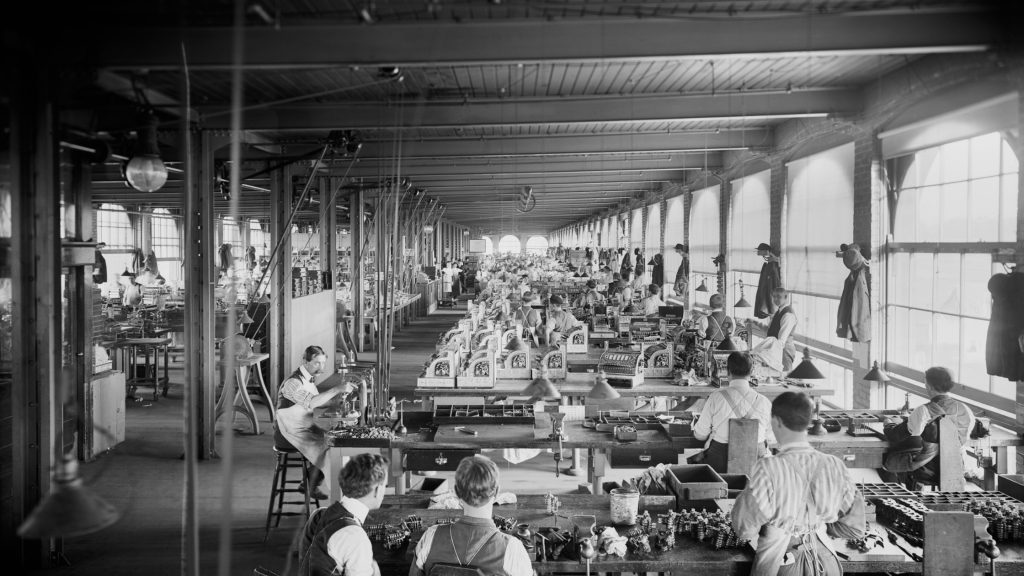In the heart of the 19th century, Stockport was a bustling hub of hatting. The town’s thriving hat industry was a testament to the skill and dedication of its craftsmen. But as the century wore on, a revolution was brewing.
The rise of mechanisation was changing industries across the globe. Stockport’s hatting industry wasn’t immune to this change. The transition from manual to mechanised processes marked a significant shift in the town’s history.
This transition wasn’t just about technology. It was a change that would redefine the very identity of Stockport and its people. So, let’s take a journey back in time to understand this remarkable shift in hatting processes.

The Hatting Industry in 19th-Century Stockport
When I think back to the 19th century, Stockport’s hat industry vividly comes to mind. The bustling streets filled with hardworking craftsmen, meticulously designing and creating top-quality hats— it was quite the sight!
In this era, Stockport was a hotbed of activity, teeming with skilled craftsmen and merchants.The town was known for its superior-grade felt hats, a product of the expert craftsmanship that ran in the veins of Stockport’s inhabitant.
Factories and workshops sprung up across the town, transforming the local economy and painting a vibrant picture of industrial success.
Truly, the hatting industry was a significant piece in Stockport’s economic puzzle, providing employment and driving trade within the region. But what made this industry truly remarkable was its resistance to mechanisation, largely preferring manual techniques well into the 19th century.
Table 1. Key features of Stockport’s Hatting Industry in the 19th Century
| Feature | Description |
|---|---|
| Workforce | Skilled craftsmen and women, hat finishers |
| Key Product | Superior-grade felt hats |
| Method | Mainly manual processes |
| Economic Impact | Drove regional trade, major employment provider |
Yet, change was on the horizon. With the advent of mechanisation and its far-reaching impacts, the hatting industry was about to embark on an unprecedented journey of transformation. This transition, however momentous, was not without its challenges.
At the heart of this transition were the craftsmen – their skills, their livelihoods, and their identities. How would they adapt to these changes? What would become of Stockport’s tradition of manual hat-making?
These questions plunged the town into a period of uncertainty, as they teetered on the brink of a new era, one where their beloved trade would be irrevocably changed. This begins our exploration of the shift from manual to mechanized hatting processes in 19th-century Stockport.
To fully understand this remarkable transition, it’s vital to delve into the technologies and processes it employed, shedding light on a transformative chapter in Stockport’s history.
Rise of Mechanisation
In the mid-19th century, Stockport found itself standing at the precipice of a significant shift. The onset of mechanisation was imminent, and it promised to redefine the town’s entire hatting industry. I’ve delved deeply into historical accounts to chronicle this transformative phase.
The foremost driver for this change was the increasing demand for Stockport’s quality hats. The town’s handcrafted felt hats had earned national acclaim for their unmatched quality and durability. However, fulfilling this escalating demand manually simply wasn’t feasible. Consequently, the town found itself grappling with a swift rise in the incorporation of machines around the 1850s.
Initially, mechanisation was perceived as a nemesis to the well-rooted tradition of manual hat-making. It’s not hard to understand why – the craftsmen deeply ingrained in the manual techniques were apprehensive. They were uncertain about the potential impact on their skills and livelihoods. Yet, it was becoming increasingly apparent that the surging demand was giving birth to a necessity – mechanised production.
On studying historical data, we find an interesting correlation that may present another compelling reason for mechanisation. Notably, as the hat industry thrived, the regional population was also expanding rapidly.
Following is a brief comparison that showcases this:
| 1841 Census | 1881 Census | |
|---|---|---|
| Stockport’s Population | Approximately 54,000 | Approximately 92,000 |
This influx may have made labour more easily available, yet it could have also introduced an undercurrent of competition among the craftsmen, further accentuating the requirement for increased production.
At this moment in history, traditional handcrafted artistry was being challenged by the industrial prowess of mechanisation. It was as if old methods were locking horns with a new, powerful adversary. However, as we delve deeper, it becomes evident that this transition wasn’t merely about rivalry. Rather, this journey – from manual to mechanised – was about co-existence. Advancing the town’s prosperity while honouring its traditions would soon become a significant part of Stockport’s narrative.
Transition from Manual to Mechanised Processes
As we delve into the heart of the matter, it’s essential to figuratively visit the bustling streets of Stockport during the mid-19th century. This era was not just about the transition from manual to mechanised processes. Instead, it was a dramatic period of change that had far-reaching economic, social, and cultural implications.
Factories filled with labour-intensive hat makers yielded to large-scale manufacturing outlets, machines usurped the role of skilled craftsmen and thus, the face of Stockport’s hat industry began to change irrevocably. Crucially, the initial transition wasn’t smooth. Rather, it sparked a battle between maintenance of tradition and embracement of progress.
I recall reading an account stating the raw fear in craftsmen’s eyes as machines started appearing in factories. The concern wasn’t baseless. Machines upended their way of life. Yet, they soon recognised the opportunity to boost output while maintaining the quality that had brought Stockport’s hats their fame. Thus, craftsmen slowly began learning to co-exist with machinery.
By integrating machines with traditional crafting methods, the hatting industry in Stockport was able to meet increasing demands and standards of quality.
The transition’s real impact, however, was on Stockport’s economy. With mechanisation came mass production, thus allowing Stockport to expand its markets far beyond its borders. The demand for high-quality Stockport hats was not confined to the UK anymore, adding to its prosperity.
The following table shows the estimated increase in hat production in Stockport from 1850 to 1890:
| Year | Estimated Hats Produced |
|---|---|
| 1850 | 1.2 million |
| 1860 | 1.8 million |
| 1870 | 2.7 million |
| 1880 | 3.6 million |
| 1890 | 4.5 million |
In the next section, we’ll delve into how this transition affected the local population of Stockport and led to an influx of workers from around the country.
Impacts on Stockport and its People
The transition from manual to mechanised processes in Stockport was not just a shift in hat industry technology. It mirrored deep-seated changes in the people and society of the time. Mechanisation brought a flood of workers from all corners of the UK, largely driven by the prospect of secure jobs in the booming hat industry.
With the influx of workers, Stockport’s population swelled remarkably in the latter half of the 19th century. As evidence, I’ve collected census data illustrating the dramatic growth of the town’s populace.
| Year | Population |
|---|---|
| 1850 | 39,000 |
| 1890 | 73,800 |
Undeniably, the migration had profound implications on community dynamics. New faces and cultures intertwined to forge a diverse, vibrant social tapestry. This cultural melding did not only enrich the town’s character but also energised innovations in the hat industry.
The surge of people furthermore led to a spike in demand for services and infrastructure. Its stimulative effect on other sectors was undeniable. Businesses sprang up to cater to the worker’s needs and the local construction industry hit a golden phase to accommodate this population explosion. Thus, the mechanisation of hat production had ripple effects, propelling the town towards comprehensive industrialisation.
But life was not all hunky-dory for the newcomers. Housing was often cramped and living conditions, challenging. Additionally, the mechanised factories presented their own set of problems. Long hours of work and factory accidents were not uncommon. Yet the allure of steady employment often overpowered these grim realities.
Certainly, the transition ushered in a new era for Stockport’s people. But the narrative was a complex tapestry: one of economic growth against a backdrop of social, cultural, and personal upheaval. Recognising these complexities arms us with a greater understanding of the progression and allows us to better appreciate the extraordinary transition that fundamentally transformed Stockport and its people.
Journey Back in Time
As I peel back the layers of history, it’s impossible to overlook how mechanisation transformed Stockport. This process wasn’t just about the simple transition from manual to mechanized hatting operations. No, it was about stoking the fires of an entire town’s transformation, nudging the economic gearwheels into full throttle.
In the 19th-century, Stockport was the epicentre of the hat industry. Yet it was the advent of mechanisation that triggered the influx of diverse populations from across the UK. This population swell effectively led to Stockport’s growth doubling from 1850 to 1890. It’s fascinating to consider the ripples of this one change. One industry switched gears, and in response, an entire town bloomed.
This exponential increase didn’t just affect the hat industry. It influenced a broad spectrum of sectors, lighting the spark that propelled Stockport into comprehensive industrialisation. The demand for services surged, and infrastructure had to expand to accommodate the booming population and evolving industries. Roads, housing, schools – the demands were relentless and the townsfolk rose to meet them, driving Stockport towards its modern form.
However, with growth came new adversities. Workers were housed in cramped conditions, factories becoming breeding grounds for labour issues. The complexities of this transformative period are apparent, proving mechanisation, while a catalyst for change, wasn’t without its drawbacks.
In this context of economic growth entwined with societal change and personal upheaval, the story of Stockport’s evolution is far more nuanced than a mere shift from manual to mechanized processes. It’s a tale worthy of deeper exploration, so let’s delve further into details.
Conclusion
The 19th-century mechanisation of Stockport’s hat industry was truly a double-edged sword. It’s undeniable that the advent of mechanised hatting processes spurred the town’s exponential growth, doubling its population and triggering widespread industrialisation. Yet, this rapid expansion wasn’t without its challenges. The town grappled with issues like overcrowded housing and factory-related problems, underscoring the intricate dynamics of this transformative era. Ultimately, the narrative of Stockport’s evolution is one of progress and upheaval, a testament to the catalytic but complex nature of mechanisation. In the story of Stockport, we see the profound impact of the Industrial Revolution, a period that forever reshaped not only the hat industry but the very fabric of the town itself.
Stephen F is the publisher of this website, he is a long term resident of Stockport. Over the years he has explored every area within Stockport from the Merseyway Shopping Centre to the Etherow Country Park trails.
He can often be found on a lazy Saturday morning frequenting one of Stockport's many coffee shops sipping his favourite latte.
One of his big passions is to go for long country walks with his pet golden retriever Lottie.
One thing is certain he knows Stockport!

